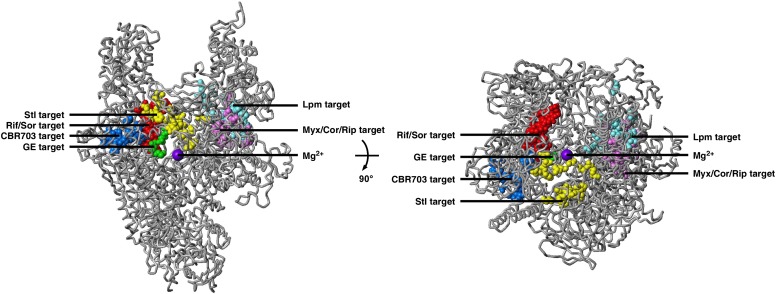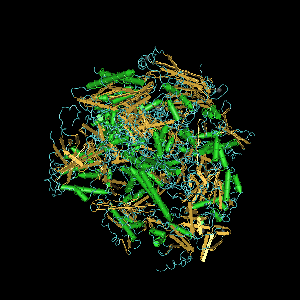Difference Between RNA Polymerase I II and III
Key Difference – RNA Polymerase I vs II vs III
RNA polymerase is an essential enzyme found in all organisms and many viruses. It is the enzyme responsible for synthesizing RNA molecule from DNA template during the process known as transcription. The genetic information stored in the DNA sequence is converted into mRNA sequence, and this reaction is catalyzed by the RNA polymerase enzyme. It is a complex protein molecule composed of different subunits. Prokaryotes possess the single type of RNA polymerase (Prokaryotic RNA Polymerase). Eukaryotes contain several types of RNA polymerases (Eukaryotic RNA Polymerase). They are RNA Polymerase I, II, III, IV and V. Among them RNA polymerase I, II and III are the main types. Each type is responsible for the synthesis of a distinct subset of RNA. RNA polymerase I catalyze the transcription of the DNA that results in rRNA of the large subunit of the ribosome. RNA polymerase II is the type of RNA polymerase that transcribes the coding strand of the DNA, which produces the mRNA. RNA polymerase III transcribes the DNA that results in rRNA of the small subunit of ribosome and tRNA. This is the key difference between RNA polymerase I, II, and III.
CONTENTS
1. Overview and Key Difference
2. What is RNA Polymerase I
3. What is RNA Polymerase II
4. What is RNA Polymerase III
5. Similarities Between RNA Polymerase I II and III
6. Side by Side Comparison – RNA Polymerase I vs II vs III in Tabular Form
7. Summary
What is RNA Polymerase I?
RNA polymerase I is a type of RNA polymerase enzyme found in higher eukaryotes. It catalyzes the transcription of rRNA molecules. The molecular size of RNA pol I is 590 kDa. It is composed of 14 different polypeptides (subunits).

RNA polymerase I is not dependent on TATA box in the promoter region. It requires upstream control elements that are located in between -200 and -107 and a core element in the region of -45 and +20.
What is RNA Polymerase II?
RNA polymerase II is a type of eukaryotic RNA polymerase enzyme. It catalyzes the trancription of DNA which codes for the synthesis of the precursors of mRNA and most of snRNA and microRNA.

RNA polymerase II is composed of 12 protein subunits, and it is 500 kDa in size. It is the most widely studied RNA polymerase enzyme type so far.
What is RNA Polymerase III?
RNA polymerase III is a type of eukaryotic RNA polymerase enzyme that is responsible for the transcription of ribosomal 5S rRNA, tRNA and other small RNAs. This is the enzyme that catalyzes the transcription of all housekeeping genes that are required in all cell types and in most environmental conditions. The size of the RNA polymerase ranges between 500 – 700 kDa. It is the largest type of eukaryotic RNA polymerase.
What are the Similarities Between RNA Polymerase I II and III?
- RNA polymerase I, II and III are three types of eukaryotic RNA polymerases.
- All enzymes are complex, multi-subunit proteins.
- All enzymes are responsible for transcription.
- All enzymes require a DNA template to produce RNA.
- All enzymes require accessory protein factors for binding and initiation of the transcription.
What is the Difference Between RNA Polymerase I II and III?
RNA Polymerase I vs RNA Polymerase II vs RNA Polymerase III | |
| RNA polymerase I | RNA polymerase I is the type of RNA polymerase that synthesizes the large subunit of rRNA. |
| RNA polymerase II | RNA polymerase II is the type of RNA polymerase that synthesizes mRNA and snRNA and microRNA. |
| RNA polymerase III | RNA polymerase III is the type of RNA polymerase that catalyzes the synthesis of tRNA and the small subunit of rRNA. |
| Sub Units | |
| RNA polymerase I | RNA polymerase I have 14 subunits. |
| RNA polymerase II | RNA polymerase II has 12 subunits. |
| RNA polymerase III | RNA polymerase III has 17 subunits. |
| Size | |
| RNA polymerase I | Size of the RNA polymerase I am 590 kDa. |
| RNA polymerase II | Size of the RNA polymerase II is 500 kDa. |
| RNA polymerase III | RNA polymerase III is 700 kDa. |
Summary – RNA Polymerase I vs II vs III
RNA polymerase is the enzyme that catalyzes the transcription process. It synthesizes RNA molecules from a DNA template. Hence, it is also known as DNA dependent RNA polymerase. There are three main types of RNA polymerases in eukaryotes namely RNA polymerase I, II and III. RNA polymerase I is responsible for the synthesis of the large subunit of ribosomal RNA. RNA polymerase II catalyzes the synthesis of precursors of the mRNA molecules and other snRNA and microRNA. RNA polymerase III is the enzyme that transcribes the DNA that results in the small subunit of rRNA and tRNA. This is the difference between RNA polymerase I, II and III.
Download the PDF of RNA Polymerase I vs II vs III
You can download the PDF version of this article and use it for offline purposes as per citation note. Please download the PDF version here: Difference Between RNA Polymerase I II and III
Reference:
1.“RNA polymerase III.” RNA polymerase III – an overview | ScienceDirect Topics. Available here
2.Paule, Marvin R., and Robert J. White. “Transcription by RNA polymerases I and III.” Nucleic Acids Research, Oxford University Press, 15 Mar. 2000. Available here
3.“RNA polymerase.” RNA polymerase – an overview | ScienceDirect Topics. Available here
Image Courtesy:
1.’GE23077-binds-to-the-RNA-polymerase-i-and-i+1-sites-and-prevents-the-binding-of-initiating-elife02450fs004’By Zhang Y, Degen D, Ho M, Sineva E, Ebright K, Ebright Y, Mekler V, Vahedian-Movahed H, Feng Y, Yin R, Tuske S, Irschik H, Jansen R, Maffioli S, Donadio S, Arnold E, Ebright R (2014). (CC BY 3.0) via Commons Wikimedia
2.’RNA polymerase II.fcgi’By Meyer PA, Ye P, Zhang M, Suh MH, Fu J – NCBI of NIH, (Public Domain) via Commons Wikimedia
ncG1vNJzZmivp6x7pbXFn5yrnZ6YsqOx07CcnqZemLyue8OinZ%2Bdopq7pLGMm5ytr5Wau26%2BzZpkqaecrrqmvsCsnGahXZa7pXnVrGSioV2Wu6V51axkoqGZZA%3D%3D